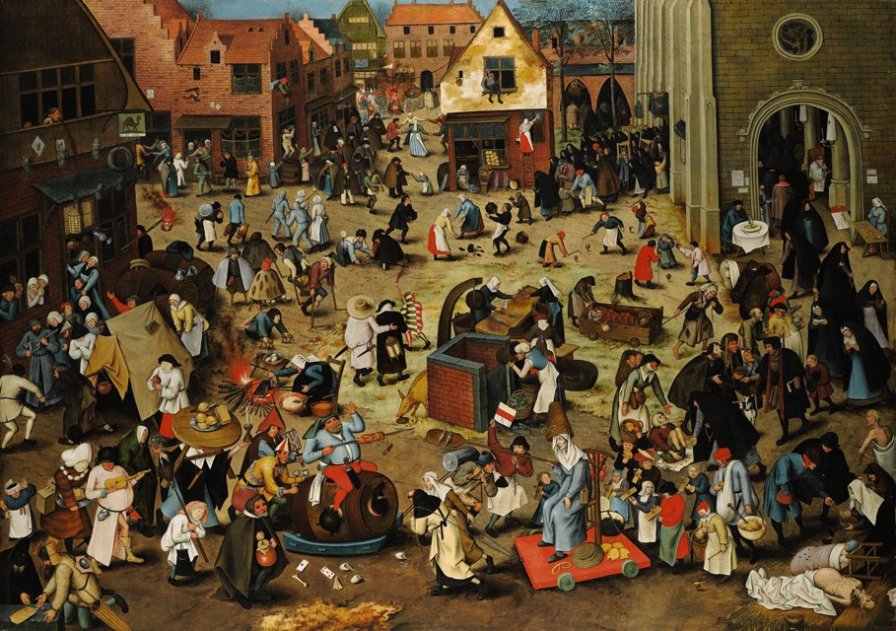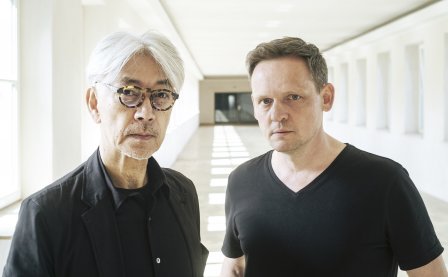We celebrate the end of the year the only way we know how: through lists, essays, and mixes. Join us as we explore the music that helped define the year. More from this series
“Nothing essential happens in the absence of noise.”
– Jacques Attali
For many of us, it has been a year in which barriers that once appeared permanent have been broken by a corrosive torrent of noises. Generalized expressions of anxiety and grief have grown so pervasive as to signify the loss of an order, doing so loudly and clearly, even as the exact substance and character of what has been lost is not as clear. This was a year in which members of “democratic societies,” with their ostensible commitment to the free exchange of ideas, began to look at our neighbors with mistrust and to feel newly isolated, our venues of public communication populated with new obstacles, dangers, and demonic images. Obviously, Trump is president, and the bumbling permutation of fascism that accompanied him has been mislabeled “populist” in its bid for control of the social imagination, bringing with it new confusions about in what exactly the “popular” sphere consists. Even the holdouts who nobly, if naïvely, defended the dignity of “fact” have to admit that information, no matter where it comes from, has become something like noise.
“Ambient music,” in the midst of this growing commotion, has taken a prominent place in the avant-garde for the first time since the initial explosion of New Age aesthetics in the 1970s. Something about it isn’t the same, though. Both paradoxically and inevitably, because what’s counted as “ambient” is inherited equally from material surroundings as from the desire to transcend them, we can’t talk about “ambience” at a time like this without implicating noise and pain. There is a deep calm on offer in the music of the Trump era, both abundant and gained through an emphasis on the domestication of harm and unrest. Little seems more exciting and relevant in music today than a healing noise, than harsh ambience.
In an essay from a couple years ago titled “Fascism in Ambient Music Culture” (currently only available via The Wayback Machine), Evelyn M. Malinowski connects the perennial reemergence of ambient music and its aesthetic of immersion with cycles of political oppression and public suffering. Malinowski goes so far as to accuse ambient music of complicity with fascism in the numb and thoughtless acceptance of the status quo that it’s apparently meant to induce. When our surroundings are noisy, bothersome, unfamiliar, and full of violence, the search for an individualized form of healing in the escape into an imagined space assumes a potentially irresponsible political connotation.
Still, ambient music today feels profoundly separate from the escapist mentality of its 1970s origins. Where Brian Eno wrote in the liner notes of Ambient 4: On Land of an affinity “with the futures that didn’t materialize, and with the other variations of the present that we suspect run parallel to the one we have agreed to live in,” the ambient music of 2017 seems to have more of an affinity with Robert Christgau’s take, who, in a review of David Toop’s Ocean of Sound, described ambient works as “microcosms to dive into, not magic carpets to escape on, and gently or subtly or harshly or esoterically or whimsically or just plain oddly [accommodating] the disturbing and the chaotic.” And while, in a text written only a few years ago, Malinowski seems more than a little bit off in lumping in with “ambient music” the Berlin Atonal festival and William Bennett’s Cut Hands and Extreme Music from Africa projects for the purpose of her political critique, today the lines, formal and social, between the ambient and such emblems of disruption and violence are not so easily drawn.

Health is enacted across times and places with little overall continuity, except for that of a few things, like an interest in the body and the forces affecting it. Music, too, is a territory redrawn and contested across space and time, understood not in regard to essence, but as a sense of connection both to a movement of/within an individual and to historically contingent methods of formalizing it. As much as the two have fought being tied to anything, health and music have been unable to shake free of one another. Apollo was the god of music and medicine, and music has been used for clinical purposes since at least as early as Hippocrates. Their tryst has endured, or have maybe been strengthened by, their respective ambiguity and mobility. It’s a thing for which discourses of health have, with surprising continuity, carved a special, if benign, place, far from the marginalized realm of the fringe, the folk, and the homespun. Discourses of music, likewise, have always taken seriously the situation of the body.
Of course, the relationship between noise and health has been articulated in different ways, and it has not always been viewed as a perfectly harmonious marriage. Where health has been tied more closely to matters of fact and of calculative precision, the clinical environment has been quieter. With the invention of the stethoscope, for example, medical spaces were “quieted under the pressure of an aesthetic that demanded a more intent theatrical listening,” according to Hillel Schwartz in Making noise: from Babel to the Big Bang and beyond, while the phenomenon of “hearing voices” has been classed as a medical problem since antiquity. Still, concepts of health and of music seem to migrate in some kind of concert. In the 1970s, the coincidence of New Age spirituality, New Age medicine, and New Age music made for a poignant episode in this relationship, both new and, like the twilight of a critical moment in public life, not unlike our own. Weary from drugs, tired of war, and having failed to remake society through the political process, young people instead remade their individual concepts of world and body. Religion, health, and music were here put into combined service, related to one another as tools for personal transformation.
Today, there is a voice that calls health, with some authority, by the name “wellness.” Pervasive discussions of “self care,” as well as corresponding changes in spiritual and aesthetic attitudes toward the body, mark the novelty of this version of health in its inward character. “Especially in this period of existence,” the Slovenian DJ E/Tape tells Resident Advisor for a recent piece on wellness and dance music, “everybody’s struggling to find a way to balance their energies.” Something about “this period of existence,” this moment in history and in culture, has imbalanced those mysteriously and subjectively apprehensible “energies” of the body. People now perceive themselves as under threat from the notions of health they were previously content, in a kind of constructed objectivity, to share with one another, and as in need of a radically individualized remedy.
“Ambient music,” always an awkward terminological stumbling block for music writers, emerged as a transformative force in music under the purview of New Age aesthetics and re-emerges in the light of this new vision of health, accompanied by vaguely familiar discussions of the body and imagined space. “Noise music,” another ambiguous coinage of critics and commenters, has always been opposed on face to “ambient music.” Instead of the latter’s loose attachments to embodied pseudo-reality, a kind of physical order, and to healing, it seems to invoke disorientation and pain. The Latin ambo, from which “ambience” is derived, means “around” or “on both sides,” calling forth the spatial character of the relationship between vibration and the shaken eardrums, the physical reality “beneath” music. “Noise,” meanwhile, is believed to come from either nausia, “disgust,” or noxia, “harm.” If pressed to conjure a general image of the noise performance, I picture a figure feverishly turning knobs and slamming on guitar pedals with the palms of their hands in a violent ritual far from the illegible austerity of the onstage ambient musician. In the world outside the obscure spaces from which these narrow images are derived, noise — at best mundane, at worst a serious threat — is a subterranean presence that comes to bear on music and its ideal ordering of relations only in those moments of crisis at which it, as in Michel de Certeau’s description of the forces of historical change, “breaks through barriers, flooding the social channels and opening new pathways that, once the flow of its passage has subsided, will leave behind a different landscape and a different order.” Noises are, by their nature, unwelcome and poorly understood wherever they occur. They signify something real and not yet ordered by the imagination. It is unclear whether noise seeks to destroy music or to become it.
In 2017, the terms “ambient” and “noise,” as impotently as they have always been put to work in describing music, seem no longer to work whatsoever. The Japanese phrase 物の哀れ, translating literally to “mono no aware” and less literally to “empathy toward things,” was borrowed by Bill Kouligas for the title of his label PAN’s compilation of “ambient tracks,” billed as such even as it features Kouligas’s shrill “VXOME” and bold contributions from artists like Helm and TCF whom many listeners would place closer to the “noise” side on the old spectrum. The “empathy toward things” displayed in this collection is something like a reconciliation of the ambient, with its complicated relationship to immanence and transcendence, with the noise that it can no longer bear to exclude.
Another artist featured on mono no aware, Yves Tumor, spent the year weaving the threads of gorgeous, looping ambience that make up Experiencing the Deposit of Faith, which Evan Coral describes in his review as a “plunge into a state of immersion,” and stumbling hazardously and unignorably around the world to his harsh noise live sets. While it may have come as a surprise to some, it seemed to me a radically appropriate sign of the character of the musical landscape when Ryuichi Sakamoto commissioned a Yves Tumor remix of “Zure” from async, an album that itself powerfully documents environmental discontinuity in a manner both ambient, like the subdued notes and sampled soundscape of “Walker,” and noisy, like the anxious buzzing and whispering of “Fullmoon.”
Earlier this year, The Guardian published an article about the “weary souls” making ambient music “cool again.” Among the artists mentioned in the piece is Suzanne Kraft, otherwise known as Diego Herrera, whose Passive Aggressive with Jonny Nash for the latter’s Melody As Truth label is as good as any demonstration of the uneasy sort of peace that became the dominant atmosphere of the musical underground in 2017. Like awkward conversational partners, software instruments quip at one another against the monolithic backdrop of silence. Parts of the record sound like parts of Eno’s Ambient albums, but the attack and decay slopes of the pads are all wrong. A track like “Refractory Cafe” mixes up our register of the acoustic and the synthetic in its juxtaposition of synthesized voices and the tangible shake of bass strings. A similarly airy and pseudo-naturalistic, New Age-adjacent palette can be heard on the “noisier” Tereza by Keru Not Ever, used to more interruptive effect, but inheriting a similar spatial sensibility.
Is Mark Harwood and Graham Lambkin’s Sirisongs more ambient or noisy? Personal assistants programmed into the operating systems of smartphones respond obliviously to wind chimes, low drones, muttered onomatopoeia, and one another, their “conversation” recorded as it shook the silence and space around it with no obvious processing. Here, too, is the noisy peace of the present, a kind of pseudo-linguistic cacophony absorbed meditatively into the background of life. Sirisongs is almost startling, in that it abstracts into nonsense the communication with technology we often perceive as essential and also almost comforting, as it brings us partly into another space where the recognizable cadence of the digital personal assistant, an element of the clamor of public life, is separated entirely from that economy of noise.
These have been but a few examples of the predicament of those aspiring to a description of the state of “ambient music” in 2017. If, like Jacques Attali claims, the “noises of a society are in advance of its images and material conflicts,” the situation of the musical avant-garde says something important about the way that the relationships between world and body, and between harm and health, are wildly in flux. While ambient music is irrevocably tied to an inward approach to healing, it is not made available without some image of the world and without the baggage of the noise that fills that world and transforms the ways we make sense of it. Noise music, while similarly connected to pain and the transgression of accepted boundaries, draws upon materials destined in its posturing as music to be incorporated into the background of life and rendered acceptable.
And in a time characterized by the expansion of both our private lives and our public sufferings, when we widely consider our identities and sources of identification to be decalibrated and broken, the cycle according to which ambience passes into noise and noise reconciles into ambience is nauseously quickened. Their rivalry doubles as an image of a bygone order. The terms we fashion in convention to classify art never last, but in times like this one, they hardly seem to do us any good at all. We shouldn’t try too hard to rescue them; instead, we should accept those classificatory ephemera as the shadows of a future in which violent transformation and peaceful restoration must be reconciled, their lines shortening and fading in anticipation of a kind of high noon.
More about: Bill Kouligas, Brian Eno, Graham Lambkin, Helm, Keru Not Ever, Mark Harwood, Ryuichi Sakamoto, Suzanne Kraft, TCF, Yves Tumor
We celebrate the end of the year the only way we know how: through lists, essays, and mixes. Join us as we explore the music that helped define the year. More from this series



